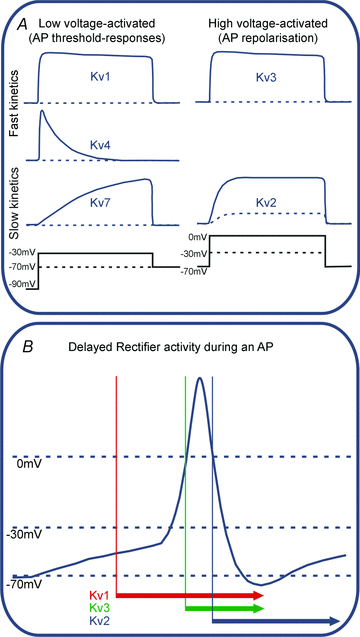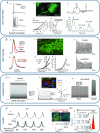Going native: voltage-gated potassium channels controlling neuronal excitability
- PMID: 20519310
- PMCID: PMC2976014
- DOI: 10.1113/jphysiol.2010.191973
Going native: voltage-gated potassium channels controlling neuronal excitability
Abstract
In this review we take a physiological perspective on the role of voltage-gated potassium channels in an identified neuron in the auditory brainstem. The large number of KCN genes for potassium channel subunits and the heterogeneity of the subunit combination into K(+) channels make identification of native conductances especially difficult. We provide a general pharmacological and biophysical profile to help identify the common voltage-gated K(+) channel families in a neuron. Then we consider the physiological role of each of these conductances from the perspective of the principal neuron in the medial nucleus of the trapezoid body (MNTB). The MNTB is an inverting relay, converting excitation generated by sound from one cochlea into inhibition of brainstem nuclei on the opposite side of the brain; this information is crucial for binaural comparisons and sound localization. The important features of MNTB action potential (AP) firing are inferred from its inhibitory projections to four key target nuclei involved in sound localization (which is the foundation of auditory scene analysis in higher brain centres). These are: the medial superior olive (MSO), the lateral superior olive (LSO), the superior paraolivary nucleus (SPN) and the nuclei of the lateral lemniscus (NLL). The Kv families represented in the MNTB each have a distinct role: Kv1 raises AP firing threshold; Kv2 influences AP repolarization and hyperpolarizes the inter-AP membrane potential during high frequency firing; and Kv3 accelerates AP repolarization. These actions are considered in terms of fidelity of transmission, AP duration, firing rates and temporal jitter. An emerging theme is activity-dependent phosphorylation of Kv channel activity and suggests that intracellular signalling has a dynamic role in refining neuronal excitability and homeostasis.
Figures






Similar articles
-
Kv3.1 and Kv3.3 subunits differentially contribute to Kv3 channels and action potential repolarization in principal neurons of the auditory brainstem.J Physiol. 2020 Jun;598(11):2199-2222. doi: 10.1113/JP279668. Epub 2020 May 16. J Physiol. 2020. PMID: 32246836
-
Regulation of Kv channel expression and neuronal excitability in rat medial nucleus of the trapezoid body maintained in organotypic culture.J Physiol. 2010 May 1;588(Pt 9):1451-68. doi: 10.1113/jphysiol.2009.186676. Epub 2010 Mar 8. J Physiol. 2010. PMID: 20211981 Free PMC article.
-
Two heteromeric Kv1 potassium channels differentially regulate action potential firing.J Neurosci. 2002 Aug 15;22(16):6953-61. doi: 10.1523/JNEUROSCI.22-16-06953.2002. J Neurosci. 2002. PMID: 12177193 Free PMC article.
-
Regulation of the timing of MNTB neurons by short-term and long-term modulation of potassium channels.Hear Res. 2005 Aug;206(1-2):133-45. doi: 10.1016/j.heares.2004.11.023. Hear Res. 2005. PMID: 16081004 Review.
-
Kv3 channels: voltage-gated K+ channels designed for high-frequency repetitive firing.Trends Neurosci. 2001 Sep;24(9):517-26. doi: 10.1016/s0166-2236(00)01892-0. Trends Neurosci. 2001. PMID: 11506885 Review.
Cited by
-
Inhibition of Kv2.1 Potassium Channels by MiDCA1, A Pre-Synaptically Active PLA2-Type Toxin from Micrurus dumerilii carinicauda Coral Snake Venom.Toxins (Basel). 2019 Jun 12;11(6):335. doi: 10.3390/toxins11060335. Toxins (Basel). 2019. PMID: 31212818 Free PMC article.
-
Enhanced Transmission at the Calyx of Held Synapse in a Mouse Model for Angelman Syndrome.Front Cell Neurosci. 2018 Jan 4;11:418. doi: 10.3389/fncel.2017.00418. eCollection 2017. Front Cell Neurosci. 2018. PMID: 29354033 Free PMC article.
-
Inverse Relationship between Basal Pacemaker Neuron Activity and Aversive Long-Term Memory Formation in Lymnaea stagnalis.Front Cell Neurosci. 2017 Jan 4;10:297. doi: 10.3389/fncel.2016.00297. eCollection 2016. Front Cell Neurosci. 2017. PMID: 28101006 Free PMC article.
-
The serotonin 5-HT2C receptor and the non-addictive nature of classic hallucinogens.J Psychopharmacol. 2017 Jan;31(1):127-143. doi: 10.1177/0269881116677104. Epub 2016 Nov 15. J Psychopharmacol. 2017. PMID: 27903793 Free PMC article. Review.
-
Physiological models of the lateral superior olive.PLoS Comput Biol. 2017 Dec 27;13(12):e1005903. doi: 10.1371/journal.pcbi.1005903. eCollection 2017 Dec. PLoS Comput Biol. 2017. PMID: 29281618 Free PMC article.
References
-
- Aldrich RW. Fifty years of inactivation. Nature. 2001;411:643–644. - PubMed
Publication types
MeSH terms
Substances
Grants and funding
LinkOut - more resources
Full Text Sources
Molecular Biology Databases

